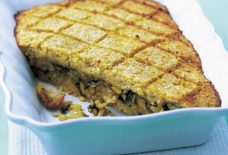Labneh (Yogurt Cheese) the Cream Cheese of Arab Cuisine
By: Blanche Shaheen/Arab America Contributing Writer
No Arab breakfast is complete without the addition of labneh (yogurt cheese), which has a consistency similar to airy cream cheese. Smooth, tart, light, and creamy, labneh gets a dose of good fats and robust flavor when drizzled with fruity olive oil. You can sprinkle this spreadable cheese with za’atar, or sweeten it with honey. With my sweet tooth, I am partial to eating labneh with apricot jam in particular. My grandmother in Bethlehem had a gigantic apricot tree, and she would fill the largest cast iron pot with hundreds of apricots and sugar to melt down into the most divine jam in the summer. I would then spoon copious amounts of the jam onto fresh labneh cheese on soft bread.
To this day a bite of sweet and sour labneh and jam sandwiches transports me to those days in my grandmother’s garden. You can store labneh by rolling the drained cheese into balls and putting them into a jar of olive oil, or just put the labneh into a glass container and top with olive oil for faster storage. This will last a couple of months in the refrigerator, that is if you have any left! What makes labneh even better than cream cheese is its hefty dose of probiotics from the yogurt.
There are two ways you can make labneh. I have provided the traditional method, using whole milk with a yogurt starter, or for a modern shortcut, you can use a tub of yogurt with a similar outcome. Either method beats store-bought, as some brands of labneh contain additional fillers and thickeners that are unnecessary. To serve this as part of a traditional Arab breakfast, serve a plate of labneh balls sprinkled with a little za’atar alongside pita bread, scrambled eggs, and a cucumber tomato salad drizzled with more olive oil. This cheese also makes a lovely sandwich filling in pita bread along with tomatoes, cucumbers, and mint, a great base for an herb dip, or a replacement for cream cheese cheesecake.
For the easy recipe tutorial, click on the video below:
Traditional Method Ingredients with Yogurt and Milk:
½ gallon whole milk
½ cup plain yogurt (full fat preferred, do not use Greek yogurt)
½ tsp salt
Olive oil
1 large very thin cotton cloth or towel
Shortcut Ingredients with Yogurt Only:
1 container (32 oz) Full fat or low-fat plain yogurt (do not use Greek)
1/2 tsp salt
Olive oil
1 large very thin cotton cloth or towel
For the traditional method, pour the milk into a pot on medium-high heat. Right when the milk begins to froth, yet just before it boils over, turn off the heat. If you have a thermometer the ideal temperature at peak heat should be 180 degrees. Let the milk cool for about 40 minutes, or until it reduces in temperature to 115 degrees. The milk should pass the old school “pinky test.” The pinky test is what my mother and grandmother used when they didn’t have a thermometer. You can do this by dipping your pinky in the milk, and if you can withstand counting to 10 seconds before the milk gets too hot for your finger, it’s time to add the yogurt. This step is important because if the milk is too hot, it will kill the live active cultures in the yogurt.
Once the milk is cooled enough, gently stir in the yogurt. Cover the pot with the lid, wrap the pot in a blanket, and let sit in a warm place in your kitchen for at least 10 hours, or even overnight. Once you remove the blanket and lid, the milk should have turned into a more solid mass. Stir in the salt. Place the clean white cotton fabric on a colander, and place the colander into a deep bowl. Pour the milk mixture into the cloth, and tie up the top with twine or a rubber band. Let this sit on your counter for at least 24 hours. This crucial step separates the liquid whey from the solid curds.
The next day the cheese should have formed, taking on a cream cheese texture. You do not want this cheese to be runny, it should be thick and pasty. The longer you let the mixture sit, the sourer it will be, which is a matter of preference. To store, you can either put the labneh in a jar and cover with olive oil, or roll the cheese into balls before covering with the oil. You must let the labneh drain for at least two days for this option of rolling into balls so that the cheese is pastier and easier to roll. If you choose this option, let the milk mixture drain in your refrigerator for the second day. Coat your hands with olive oil, and take a tablespoon of labneh and roll with your hands into a ball. Repeat and put all of the labneh balls into a sterile airtight jar and cover with olive oil to the top.
For the easy shortcut, take the yogurt and combine with the salt, and practice the same method as before. Pour the yogurt into a towel-lined colander with a bowl underneath, and let drain for 24 hours or overnight. To store the labneh for later use, just roll them into balls and cover with olive oil. If you would like to serve the labneh right away, spread it on a plate and drizzle with olive oil, and sprinkle with za’atar or any kind of herb or seasoning you wish.
Blanche Shaheen is a journalist, host of the cooking show called Feast in the Middle East, and soon to be cookbook author. She specializes in Arab cuisine of the Levant and beyond. You can check out her cooking video tutorials and cultural commentary on growing up Arab American at https://www.youtube.com/user/blanchetv Her recipes can also be found at https://feastinthemiddleeast.wordpress.com/



